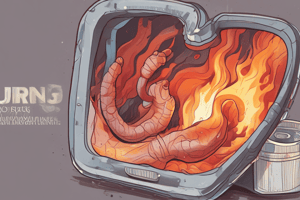Podcast
Questions and Answers
Calculate the burn injury using the Rule of Nines for a client with burns affecting the entire face and upper half of the anterior torso. What is the percentage affected?
Calculate the burn injury using the Rule of Nines for a client with burns affecting the entire face and upper half of the anterior torso. What is the percentage affected?
- 36% (correct)
- 18%
- 48%
- 24%
How much fluid should be infused over the first 24 hours for a client weighing 174.74 lbs with a TBSA of 36%?
How much fluid should be infused over the first 24 hours for a client weighing 174.74 lbs with a TBSA of 36%?
11,376 mL
Calculate the total fluid to be infused in the first 8 hours for an adult burn victim weighing 81 kg with a TBSA of 19%.
Calculate the total fluid to be infused in the first 8 hours for an adult burn victim weighing 81 kg with a TBSA of 19%.
- 2,798 mL
- 6,156 mL
- 3,078 mL (correct)
- 12,312 mL
What is the rate of IV fluid required in the first 24 hours for a patient who has burns on approximately 42% of his body and weighs 78 kg?
What is the rate of IV fluid required in the first 24 hours for a patient who has burns on approximately 42% of his body and weighs 78 kg?
What is the mL/hr rate to be infused in the first 8 hours after arrival for the same patient?
What is the mL/hr rate to be infused in the first 8 hours after arrival for the same patient?
Using the Rule of Nines, estimate the extent of burn injury for the areas burned: anterior trunk, anterior left arm, and posterior left leg.
Using the Rule of Nines, estimate the extent of burn injury for the areas burned: anterior trunk, anterior left arm, and posterior left leg.
Which client is most at risk for compartment syndrome due to a burn?
Which client is most at risk for compartment syndrome due to a burn?
What would be the TBSA for a 47 year old male client weighing 91 kg with burns on his entire head, upper anterior torso, anterior right and left arms, and genitalia?
What would be the TBSA for a 47 year old male client weighing 91 kg with burns on his entire head, upper anterior torso, anterior right and left arms, and genitalia?
Using the Parkland Formula, calculate the mL/hr in the first 8 hours of the client's arrival for the above patient.
Using the Parkland Formula, calculate the mL/hr in the first 8 hours of the client's arrival for the above patient.
For a burn victim in the first 24 hours, which type of fluid would the doctor most likely order?
For a burn victim in the first 24 hours, which type of fluid would the doctor most likely order?
Using the Parkland Formula, what is the fluid to be infused in the first 8 hours after arrival for a patient weighing 80 kg with specific burn injuries?
Using the Parkland Formula, what is the fluid to be infused in the first 8 hours after arrival for a patient weighing 80 kg with specific burn injuries?
After the first 8 hours for a burn patient receiving Lactated Ringer's with an initial volume of 30,000 mL, what should be the rate of IV fluids?
After the first 8 hours for a burn patient receiving Lactated Ringer's with an initial volume of 30,000 mL, what should be the rate of IV fluids?
Flashcards are hidden until you start studying
Study Notes
Rule of Nines
- Burns affecting the anterior half of the head account for 4.5% TBSA.
- The upper half of the anterior torso equals 9% TBSA.
- Each lower arm contributes 4.5% TBSA; both equal 9% TBSA combined.
- The posterior half of the head adds another 4.5% TBSA.
- The upper half of the posterior torso constitutes 9% TBSA.
- Total burn injury calculated using these measurements can be 36% TBSA.
Parkland Formula
- Fluid resuscitation calculated as: 4 mL × TBSA (%) × weight (kg).
- For a patient weighing 174.74 lbs (79 kg) with 36% TBSA, total fluid volume for the first 24 hours is 11,376 mL.
- In the first 8 hours, half of the total volume (5,688 mL) is administered.
Fluid Calculation Examples
- For a patient weighing 81 kg with 19% TBSA, volume calculated is 3,078 mL in 24 hours.
- For another patient weighing 78 kg with 42% TBSA, total volume is 13,104 mL in 24 hours, leading to 819 mL/hr for the first 8 hours.
Additional Calculations
- A patient with burns on anterior trunk, anterior left arm, and posterior left leg totals 31.5% of TBSA.
- Circumferential burns, especially on extremities, pose a high risk for compartment syndrome.
Fluid Resuscitation Dynamics
- Clients with massive burns typically receive Lactated Ringer's solution for fluid resuscitation, as it helps to neutralize metabolic acidosis often present post-injury.
- After initial 8-hour fluid administration, the rate should be adjusted to provide remaining fluids over the next 16 hours.
Study Cases
- Adult patient with burns on the entire head, anterior torso, arms, and genitalia calculated to have 28% TBSA. Initial fluid rate post-arrival determined at 637 mL/hr.
- In a case involving an adult with anterior trunk and arm burns, TBSA calculated at 22.5%, necessitating 3,600 mL in the first 8 hours.
Summary
- Total fluid requirements after burns vary based on TBSA and weight, using the Parkland Formula.
- Close monitoring of fluid rates and adjustments post-initial resuscitation critical for recovery.
Studying That Suits You
Use AI to generate personalized quizzes and flashcards to suit your learning preferences.




